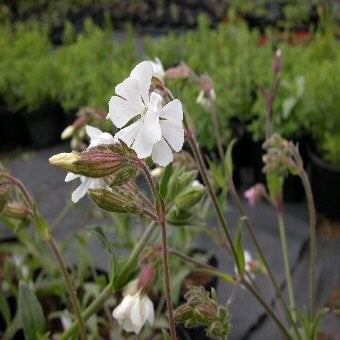White Campion is a perennial wildflower found in open wasteground, hedgerows and meadows. It flowers May to October, producing large white flowers, scented in the evenings. White Campion grows to about 3 ft (1 m) high and is a member of the Pink family. The Silene part of its botanical name comes from Silenus, the Greek satyr and god. Someitmes it hybridizes with Red Campion, producing a lovely pale pink flower.
It was believed that picking this flower would lead to your mother’s death. In Luxemburg, picking the plant would bring thunder. In Cumberland it was often known as White Riding Hood. It is also known as the ‘Grave Flower’ or ‘Flower of the Dead’ as it can be seen growing in graveyards and around tombstones.
White Campion was one of the ingredients in 16th Century Elizabethan pot pourri. The root has been used as a soap substitute for washing clothes, hair etc. It is thought to have been introduced to the country by neolithic farmers as remains of it have been found on neolithic and Bronze Age sites.
Benefits of White Campion for Wildlife
White Campion is a great wildflower for moths! It is the food plant of the Marbled Coronet, Marbled Clover and Sandy Carpet moths. It is also liked by bees and butterflies.
How to Sow White Campion Seeds
White Campion germinates well and is easy to sow! You can sow direct where you want it to flower (semi-shade or sunny spot) by scattering onto the soil and pressing gently into the soil. No need to rake over. Water as required. Alternatively, you can sow in trays of compost and, when the seedlings are big enough to handle, remove them carefull from the tray and grow them on individually in post of compost until ready to plant out in the garden.





